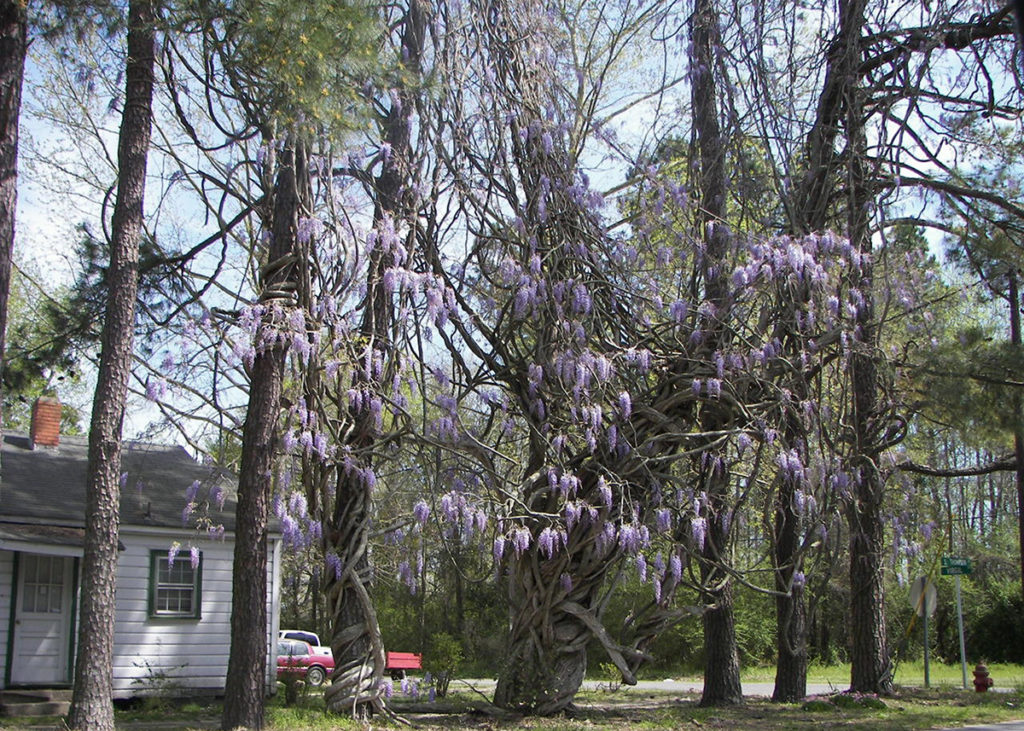Chinese/Japanese Wisteria
Wisteria is typically found around old houses. There are two species of wisteria that have escaped in the eastern United States: Chinese wisteria and Japanese wisteria. Once established, wisteria can be difficult to eradicate and can persist for years, strangling native trees and shrubs. They can kill or disfigure desirable trees in the landscape.

Vegetative Growth
Chinese and Japanese wisterias have some distinguishing vegetative differences. Chinese wisteria twines counterclockwise while Japanese wisteria twines clockwise. Leaves on Chinese wisteria can have 7–13 leaflets, although usually 11, while leaflets on Japanese wisteria range from 13 to 19. However, with some overlap in leaflet characteristics and the presence of hybrids (Wisteria x formosa Rehd.), positive identification can be difficult.
In general, all wisterias have pinnately compound leaves arranged alternately on the stem. Leaflets tend to be elliptic to ovate shaped and 1–4 inches long. Unlike American wisteria [Wisteria frutescens (L.) Poir.], which reaches 15–25 feet, Chinese and Japanese wisterias are high-climbing vines reaching upward of 70 to 80 feet. The record-holding Chinese wisteria in Sierra Madre, California, was recorded with a stem length of over 450 feet. Chinese and Japanese wisterias are usually only limited by the support on which they grow. Wisteria stems (vines) wrap very tightly, slowly killing live supports, such as trees. Stems are relatively smooth with light brown or tan bark. Both vertical and lateral stems are produced. Lateral stems trail across the ground, rooting along the plant’s length, and usually tighten with age. Removal of either type of stem can be difficult.
Flowering and Seeds
Chinese and Japanese wisterias bloom in spring, before leaves emerge. Fragrant flowers are produced in hanging clusters with purple, violet, or white petals. Flowers develop into a densely hairy (velvety pubescent) legume (seedpod) that contains one to four seeds
Dispersal
Wisteria is dispersed vegetatively by stem growth or sexually by seed. The fruit is poisonous and most likely not dispersed frequently by wildlife. Intentional planting as an ornamental for landscape purposes most likely enabled invasions in most areas of the United States.
Habitat
Wisterias can be a problem in fence rows, forests, and landscapes. Wisteria forms dense thickets, replacing the surrounding vegetation. Although these thickets may provide habitat for certain wildlife, they are a difficult barrier for human and animal activity.
Distribution
Chinese and Japanese wisterias are reportedly widespread in the eastern United States, but the presense of fertile hybrids may compromise current species distribution. American wisteria has a similar distribution in the United States, ranging from Massachusetts to Michigan and south to Florida and Texas. All are cultivated, especially Chinese and Japanese wisterias and their hybrids. Wisterias are widespread in the Midsouth. American wisteria is generally not as aggressive and occurs in and around wetlands.
Control Methods
Chemical
More research is needed on wisteria control, since there are few labeled recommendations. See Table 1 for recommended chemical applications. These herbicides can be applied in a variety of methods that include foliar, frill, basal bark, cut stump, or soil treatments. Frill (also known as hack and squirt) requires a hatchet, machete, or ax to create an opening in the bark every 2 inches around the woody stem; the herbicide is applied in these openings. Basal bark applications are made by spraying the lower 18–24 inches of the entire plant trunk with a bark-penetrating adjuvant. These treatments are most effective on trunks less than 4 inches in diameter and when treated just before bud break. Cut stump applications are made after severing the main stem. Apply herbicide to the remaining stump just inside the bark to prevent resprouting. All foliar and basal bark applications also require a nonionic surfactant at 32–64 ounces per 100 gallons of spray solution. Picloram is absorbed by tree roots, so applications made within two times the dripline of desirable trees may cause injury or death. Clopyralid can be sprayed overtop a variety of desirable trees; it can be a good choice for treating wisteria that has draped trees.
Mechanical
Mechanical controls can be used, but they tend to be expensive and labor intensive. Lateral stems (vines) are produced at the base of climbing stems and can run extended distances from the original plant. Climbing vines can twine tightly around trees and shrubs, making removal difficult. Young shoots can be snapped to prune, but older vines require cutting.
Information and resources provided by Mississippi State University Extension Service, http://extension.msstate.edu/publications/publications/wisteria.
